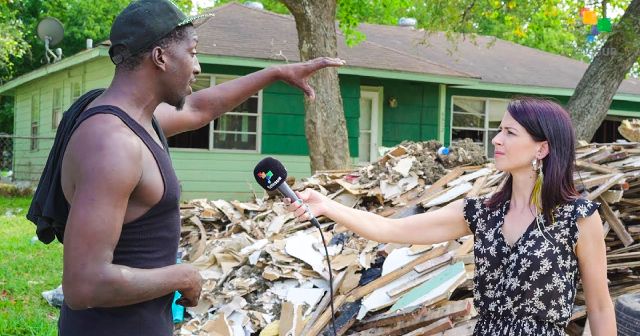Houston’s lack of zoning and regulations maximized the impact of Hurricane Harvey, with “fence-line communities” deliberately put in harm’s way
by Emma Fiala
In this second installment of special coverage Hurricane Harvey’s aftermath, Abby Martin explores how the petrochemical industry dominates the city and why its low-income, Black and Latino areas are in the highest-risk areas for flooding and pollution, earning them the name “sacrifice zones.”
Abby explores Houston’s unique lack of zoning and regulations that maximized the impact of the storm, the “fence-line communities” deliberately put in harm’s way, inhumane treatment of incarcerated people in the disaster, and how the ownership of the city by Big Oil puts thousands of lives in peril.
Featuring interviews with Dr. Robert Bullard, professor of Urban Planning and Environmental Policy at Texas Southern University; Azzurra Crispino, co-founder of Prison Abolition Prisoner Support (PAPS); and Yvette Arellano of the Texas Environmental Justice Advocacy Series.
In the first installment in a series on Hurricane Harvey recovery, Abby Martin introduced viewers to a neighborhood ignored by both state and national officials during and after the hurricane. It quickly became clear that the neighborhoods Abby drew attention to, specifically Lake Forest Park, were home to working-class Houston residents of a lower socioeconomic status, many of which are Latino or Black. Was it a simply a coincidence that these neighborhoods were affected by the deadly flooding more than others? Is it by chance that these neighborhoods are now receiving far less attention than those filled with middle to upper-class white Houstonians?
According to the evidence presented in the second installment in the series on Hurricane Harvey, the answer is a very clear no – there was no coincidence and nothing was left to chance. In fact, these very neighborhoods are referred to as “sacrifice zones,” having numerous shortcomings in addition to the tendency to flood.
Houston is unique in that it lacks zoning laws. It is also overrun with petrochemical corporations operating with few rules and regulations.
Neither of these things lend to a safe and healthy city for those with few resources. Houston has a high amount of residential segregation and housing discrimination which forces residents seeking affordable housing into marginalized areas where they are exposed to higher amounts of pollutants, less access to amenities, and are often at a higher risk of flooding. Abby spoke with Dr. Robert Bullard, Professor of Urban Planning at Texas Southern University, about these issues including Houston’s history, gentrification of the city, where wealth is focused, and how modern weather events affect these communities.
Not only were Houston residents affected adversely by the structure of the city, inmates being held in three prisons in the area were all but ignored during the disaster. Abby spoke with Azzurra Crispino, from Prison Abolition Prisoner Support, about what inmates experienced, including standing water, the inability to bathe for at least 10 days, and reports that when portable toilets were finally made available, they were only accessible to prison staff. In one unit, 500 men were evacuated to a gymnasium where they stayed and slept in close quarters without air conditioning or functioning fans, near portable toilets that were not being emptied or cleaned, and with insects and reptiles roaming the floors at night. Despite being located on a floodplain, the facility does not have an evacuation plan in place, lending to numerous health and safety concerns for inmates.
Abby also spoke with Yvette Arellano of the Texas Environmental Justice Advocacy Services. Yvette shared details surrounding the dangerous situation that unfolded at a chemical plant in Houston after Hurricane Harvey hit the area. As the emergency at the chemical plant began, the surrounding community was not informed of the situation, despite seeing smoke and flames at the plant. As time went on, few details were shared about what chemicals were stored at that particular plant and if the situation posed any immediate threat to the surrounding residents.
Chemical plants like this are no longer required to be transparent when it comes to their operations due to the supposed threat of terrorist attacks. While hiding behind Homeland Security in an effort to keep the country safe, the communities surrounding these facilities are left in an unsafe position, completely unaware of potential disasters looming right around the corner. In fact, FEMA stepped up to make the community aware of the threat posed to the community as the emergency unfolded, but the very next day rescinded those statements due to pressures from above. Not only were communities subjected to significantly polluted air due to emergency situations at individual chemical and oil plants in the area, floodwaters were contaminated as well, putting residents at risk in the midst of harrowing rescues.
Shockingly, there is a 16 mile stretch of residential communities located on the edge of the second largest petrochemical complex in the world, running from Houston to Louisiana, filled with cancer clusters and extremely high emissions. Not only is this harmful situation allowed in the United States, there were no extra precautions taken to protect these communities during the disaster, communities full of children. These communities are subjected to harmful emissions daily and those emissions increased dramatically after the hurricane. The correlation is obvious – the higher the poverty rate in these areas, the greater the rate of harmful emissions. Human lives are sacrificed for the profit of the petrochemical industry, with major plants in view of elementary school playgrounds.
Houston is dominated by the petrochemical industry with little regard to the health and safety of it’s most vulnerable residents. Hurricane Harvey did not cause this problem but it has finally brought more of the shocking situation to light. Profits are valued over people in Houston and the basic structure of the city along with it’s laws and regulations are proof.



